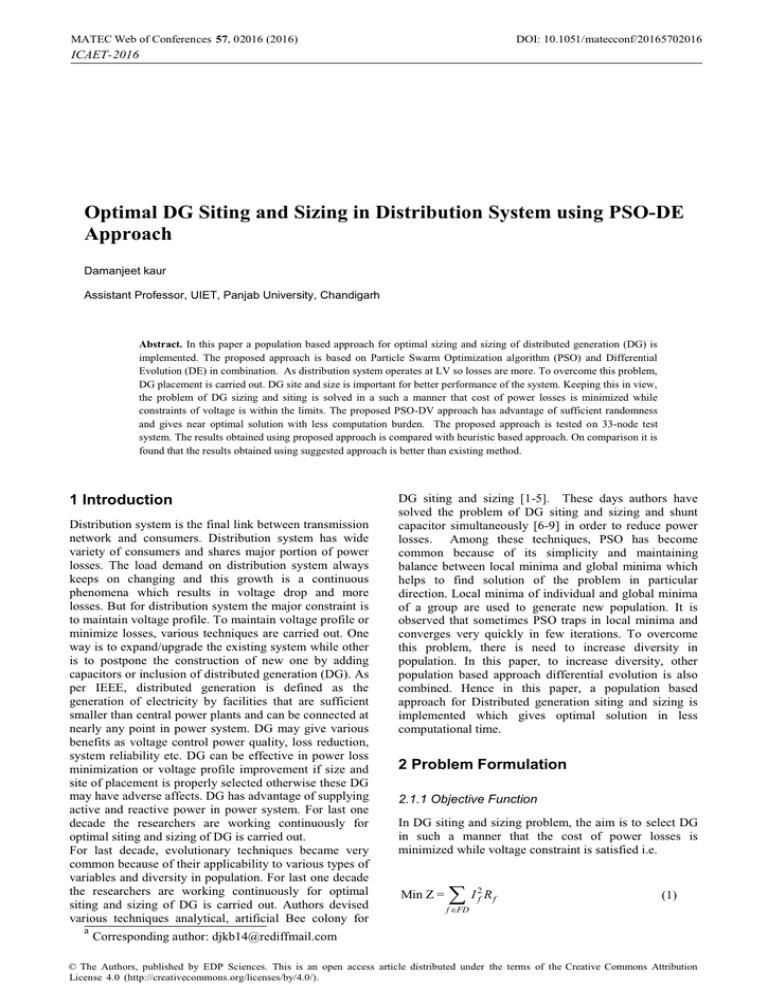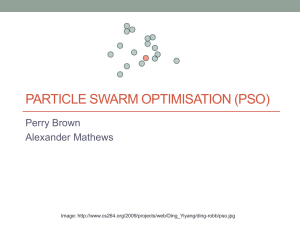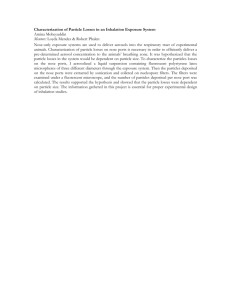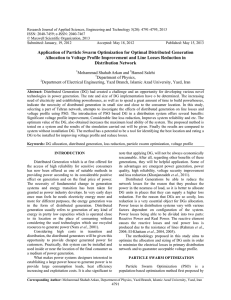Optimal DG Siting and Sizing in Distribution System using PSO-DE Approach
advertisement

MATEC Web of Conferences 57, 02016 (2016) DOI: 10.1051/ matecconf/20165702016 ICAET- 2016 Optimal DG Siting and Sizing in Distribution System using PSO-DE Approach Damanjeet kaur Assistant Professor, UIET, Panjab University, Chandigarh Abstract. In this paper a population based approach for optimal sizing and sizing of distributed generation (DG) is implemented. The proposed approach is based on Particle Swarm Optimization algorithm (PSO) and Differential Evolution (DE) in combination. As distribution system operates at LV so losses are more. To overcome this problem, DG placement is carried out. DG site and size is important for better performance of the system. Keeping this in view, the problem of DG sizing and siting is solved in a such a manner that cost of power losses is minimized while constraints of voltage is within the limits. The proposed PSO-DV approach has advantage of sufficient randomness and gives near optimal solution with less computation burden. The proposed approach is tested on 33-node test system. The results obtained using proposed approach is compared with heuristic based approach. On comparison it is found that the results obtained using suggested approach is better than existing method. 1 Introduction Distribution system is the final link between transmission network and consumers. Distribution system has wide variety of consumers and shares major portion of power losses. The load demand on distribution system always keeps on changing and this growth is a continuous phenomena which results in voltage drop and more losses. But for distribution system the major constraint is to maintain voltage profile. To maintain voltage profile or minimize losses, various techniques are carried out. One way is to expand/upgrade the existing system while other is to postpone the construction of new one by adding capacitors or inclusion of distributed generation (DG). As per IEEE, distributed generation is defined as the generation of electricity by facilities that are sufficient smaller than central power plants and can be connected at nearly any point in power system. DG may give various benefits as voltage control power quality, loss reduction, system reliability etc. DG can be effective in power loss minimization or voltage profile improvement if size and site of placement is properly selected otherwise these DG may have adverse affects. DG has advantage of supplying active and reactive power in power system. For last one decade the researchers are working continuously for optimal siting and sizing of DG is carried out. For last decade, evolutionary techniques became very common because of their applicability to various types of variables and diversity in population. For last one decade the researchers are working continuously for optimal siting and sizing of DG is carried out. Authors devised various techniques analytical, artificial Bee colony for a DG siting and sizing [1-5]. These days authors have solved the problem of DG siting and sizing and shunt capacitor simultaneously [6-9] in order to reduce power losses. Among these techniques, PSO has become common because of its simplicity and maintaining balance between local minima and global minima which helps to find solution of the problem in particular direction. Local minima of individual and global minima of a group are used to generate new population. It is observed that sometimes PSO traps in local minima and converges very quickly in few iterations. To overcome this problem, there is need to increase diversity in population. In this paper, to increase diversity, other population based approach differential evolution is also combined. Hence in this paper, a population based approach for Distributed generation siting and sizing is implemented which gives optimal solution in less computational time. 2 Problem Formulation 2.1.1 Objective Function In DG siting and sizing problem, the aim is to select DG in such a manner that the cost of power losses is minimized while voltage constraint is satisfied i.e. Min Z = I 2 f Rf (1) f FD Corresponding author: djkb14@rediffmail.com © The Authors, published by EDP Sciences. This is an open access article distributed under the terms of the Creative Commons Attribution License 4.0 (http://creativecommons.org/licenses/by/4.0/). MATEC Web of Conferences 57, 02016 (2016) DOI: 10.1051/ matecconf/20165702016 ICAET- 2016 Where If- Current flowing through a branch f To find optimal size of conductor, fitness function is defined corresponding to the objective function. For each particle p, fitness function is evaluated. Rf- Resistance of branch f FD-Total number of feeder segments in a feeder 2.1.2 Constraints C. Find Local Best and Global Best (i) After calculation of fitness function, the best fitness function for each particle and among swarm is found out. The best fitness function of particle p is known as Pbest and that of swarm is defined as Gbest. Voltage Constraint The size of DG should be selected such that voltage at each node np should be within the prescribed limit as: Vmin Vnp Vmax (ii) (2) D. At First Iteration After calculation of fitness, at iteration u=1, Gbest is considered equal to Pbest. Compare the fitness value of the particle p at u+1 with that of the previous best one. Power Balance Constraint The total active power generated by generators and DGs should meet load demand and power losses i.e. Ng Pg g 1 gw / DG NDG Pg G 1 G E. Choose Value of Probability Pd PL A value of probability variable (P) is chosen in order to apply either PSO or DE for next generation. The value is set by the user. (3) Where Ng- Number of traditional generators in given system NDG-Number of DG’s Pg gw/ DG - Operating active power of traditional F. Updation of Velocity and Position Vector If value of P is less than the user defined value then update velocity and position vector of particle p using Gbest and pbest till iteration u+1 using following equations. power generation unit g with introduction of DG Pd- Total load demand PL- Total active power losses PgG -Active power of DG unit G Vel up 1 ( wVel up c1rand1 ( pbest Pos up ) c2 rand 2 ( gbest Pos up ) Assumptions for DG Sizing and Siting (i) DG is working at upf. (ii) DG is supplying only real power. (iii) Only single DG can be placed. posup1 posup Vel up 1 (4) (5) where rand1 and rand2 are random numbers generated in [0, 1]; c1 an c2 are acceleration constant; w is the inertia weight factor, it provides balance between global and local explorations. w often decreases from 0.9 to 0.4 during the iterations. It is generally set using the following equation: 3 Solution Approach The proposed approach consists of PSO and DE in combination to increase the search diversity in order to get optimal solution for the same. In the proposed approach PSO explores the potential optimal regions within reasonable short period of time and then DE searches this space rapidly. Therefore the proposed approach is able to find global solution of the problem. w wmax ((wmax wmin ) / kmax )* k (6) The algorithm of the proposed approach is as described below [10-12]: where Umax is the maximum number of iterations and u is the current number of iteration. A. Generation of Population Otherwise apply mutation, crossover and selection operators of DE as given in the following sections. Initially a population of individuals is generated. In PSO, individuals are termed as particle and group of population is known as swarm. Each particle p at kth iteration has velocity ( Veluk ) and position ( posuk ) within the search space. In this paper, each particle represents the discrete sizes of conductors for nbr feeder segments. G. Mutation To produce population for next iteration, u=u+1, a mutation operator is applied at the current population at u=1. Three particles (P1,u, P1,u, P1,u) are selected randomly and a mutant vector is generated as given below: B. Fitness Function 2 MATEC Web of Conferences 57, 02016 (2016) DOI: 10.1051/ matecconf/20165702016 ICAET- 2016 Mu tan t P3,u F ( P1,u P2,u ) reactive load is 3.72 MW and 2.3 MVAR. The line and load data is given in [5]. Initially sensitivity analysis of real power losses w.r.t active power injection for the given data is carried out. The nodes are placed in descending order corresponding to the sensitivity value as given in Table 1. First of all 15 nodes are considered as candidate nodes for DG siting. A set of population is generated for given number of candidate nodes. Fitness function for the generated population is calculated. Store Pbest and Gbest value of the current iteration of population. Update these values position and velocity values as explained in Section 3. (7) where F is constant having value between 0 and 1. H. Crossover To increase diversity in search space, in DE trial vectors are generated by applying crossover between earlier generation at uth iteration and mutant vector. The trial vector is obtained by comparing the random number generated between 0 and 1 and crossover probability selecting a crossover probability (P cross). If random number is greater than the Pcross then design variable of trail vector will be from mutant vector otherwise from uth iteration generation. Table 1-Nodes in Descending order corresponding to sensitivities Nodes in Descending order Value of Sensitivity I. Selection corresponding to sensitivity 18 17 16 15 14 13 33 32 31 12 11 30 10 29 9 28 8 27 7 26 6 5 25 24 4 23 3 22 21 20 19 2 The selection is carried out if the trial vectors will be part of new population or not. To decide this, fitness function of trail vector is calculated and compared with Pbest. If it is better than earlier then Pbest, then trial vector is considered as particle for new generation and store new value of Pbest. J. Updation of Pbest and Gbest Update Pbest and Gbest corresponding to best trial vector. K. Stopping Criteria The above steps of subsection E to J is repeated till the search satisfies the termination condition. The termination condition may be maximum number of iterations or the convergence criteria set. 3.1 Algorithm for Distributed Generation (i). Choose values c1, c2, number of particles and number of iterations. (ii). Perform sensitivity analysis of real power losses w.r.t active power injection as given in [13]. (iii).Sort nodes in descending order corresponding to their sensitivity obtained. (iv). Select first n number of nodes as candidate locations for DG placement. (v). Generate a group (n) of particles for candidate locations within the d-dimensional search space of the problem i.e. the size of distributed generation alongwith position and velocity of each particle. (vi). Modify population as in Section 3. (vii). Repeat above Steps till maximum number of iterations are achieved. -0.0013 -0.0013 -0.0012 -0.0012 -0.0012 -0.0012 -0.0011 -0.0011 -0.0011 -0.0011 -0.001 -0.001 -0.001 -0.001 -0.0009 -0.0009 -0.0008 -0.0008 -0.0007 -0.0007 -0.0007 -0.0005 -0.0005 -0.0004 -0.0004 -0.0003 -0.0003 -0.0001 -0.0001 -0.0001 -0.0001 0 After a given number of iterations, the best solution obtained is as mentioned in Table 2. It is found that considering DG of size 50 % of total loading results 1.4567 MW DG placement at bus 12 which causes power losses of 122.69 MW. DG placement causes minimum voltage at bus 33 of 0.9379 p.u. On comaprison with existing heuristic approach it is clear from Table 2 that the proposed approach yields better results than existing 4. Results and Discussions The proposed approach is tested on 12.66 kV, 33 bus radial distribution system is considered. The total real and 3 MATEC Web of Conferences 57, 02016 (2016) DOI: 10.1051/ matecconf/20165702016 ICAET- 2016 method. The suggested approach has less power losses as compared to other method. References 1. Table 2-Comparison with Other Method for 50% Loading Base Case Total %Loss Optimal Minimum Real Reduction Location Voltage 2. the System (MW) (p.u.) - - 0.9065 M. R. Haghifam, H. Falaghi and O.P. Malik, “Riskbased distributed generation placement. IET Generation, Transmission and Distribution, Vol. 2, pp252–60, 2008. 3. N. Acharya, P Mahat, and N. Mithulananthan, “ An analytical approach for DG allocation in primary distribution network.,” Electric Power Systems Research, Vol. 28, No.10, pp 669-678, 2006. 4. P. S. Georgilakis and N. D. Hatziargyriou, “Optimal distributed generation placement in power distribution networks: Models, methods, and future research,” IEEE Transaction on Power Systems Vol. 28, pp 3420–8, 2013. 5. T.N Shukla, S.P. Singh, V. Srinivasarao, and K.B. Naik, “Optimal sizing of distributed generation placed on radial distribution systems,” Electrical Power Component System, Vol. 38, No. 3, pp 260274, 2010. 6. S.A. Taher, M. Hasani and A. Karimian, “ A novel method for optimal capacitor placement and sizing in distribution systems with nonlinear loads and DG using GA,” Communications in Nonlinear Science and Numerical Simulation, Vol. 16, No 2, pp 851862, 2011. 7. S.M Sajjadi, M.R. Haghifam, and J. Salehi, “Simultaneous placement of distributed generation and capacitors in distribution networks considering voltage stability index,” International Journal of Electrical Power & Energy Systems, No. 46,pp 366375, 2013. 8. V. A. Evangelopoulos and P.S. Georgilakis, “Optimal distributed generation placement under uncertainties based on point estimate method embedded genetic algorithm,” IET Generation Transmission and Distribution , Vol 8, pp 389–400, 2014. 9. S. Gopiya Naik, D.K. Khatod, M.P.Sharma, “ Optimal Allocation of Combined DG and Capacitor for Real Power Loss Minimization in Distribution Networks,” Electrical Power and Energy Systems, Vol 53, pp 967-973, 2013. 10. J. Kennedy and R. Eberhart, “Particle Swarm Optimization,” IEEE Proceedings on 1st International Conference on Neural Networks (Perth, Australia), 1942-1948, 1995. 11. J. Kennedy and R. Eberhart, “A Discrete Binary Version of the Particle Swarm Algorithm,” IEEE Conference on Systems, Man, and Cybernetics, Orlando, FA, 4104-4109, 1997. 12. K. Price, R. Storn and J. Lampinen, Differential Evolution-A Practical Approach to Global Optimization, Springer, Berlin Heidelberg New York, 2005. in Losses 213.3 at Bus 18 Heuristic 142.34 22.83 Approach 1.0 MW 0.9311 DG at bus bus 33 at 18 Proposed 122.69 42.48 Approach 1.4567 0.9379 MW DG at bus 33 at bus 12 The results are also compared for size of DG as 50% of total loading with heuristic approach in which only node number 17 and 18 are considered as sensitive nodes. On implementation it is found that The suggested approach yields better results than existing heuristic approach as tabulated in Table 3. Table 3-Comparison of results with same search space for 50% loading Total Real %Loss Optimal Minimum Losses Reduction Location Voltage in (MW) the System (p.u.) Base Case 213.3 - - 0.9065 (No DG) Heuristic at Bus 18 142.34 22.83 Approach 1.0 MW 0.9311 DG at bus bus 33 at 18 Proposed Approach 138.1950 35.21 0.9886 MW DG at bus 17 0.9310 bus 33 F.S Abu-Mouti and M.E.El-Hawary, “Optimal distributed generation allocation and sizing in distribution systems via artificial bee colony algorithm,” IEEE Transactions on Power Delivery, No 26 Vol. 4, pp 2090-2101, 2011. at Conclusions In this paper a population based approach for DG placement in radial distribution system is proposed. The problem of DG siting is solved using sensitivity analysis method of real power losses w.r.t active power injection which gives candidate nodes for DG siting. For fixed number of candidate nodes, DG sizing problem is solved using particle swarm optimization and DE approach in combination . The results obtained are compared with heuristic approach. On comparing the results it is found that proposed approach is suitable to find quality solution in less computational time. 13. D. K. Khatod, V. Pant, and J.D. Sharma, “A Novel Approach for Sensitivity Calculations in the Radial 4 MATEC Web of Conferences 57, 02016 (2016) DOI: 10.1051/ matecconf/20165702016 ICAET- 2016 Distribution System,” IEEE Transactions on Power Delivery, vol. 21, no. 4, pp. 2048-2057, October 2006. 5






